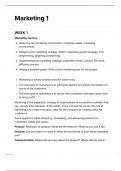Marketing 1
WEEK 1
Marketing Journey
1. Analyzing the marketing environment: Customer needs, marketing
environments
2. Designing the marketing strategy: SWOT, marketing growth strategy, STG
(segmenting, targeting, positioning)
3. Implementing the marketing strategy: proposition levels, product life cycle,
diffusion process
4. Writing a marketing plan: Write a brief marketing plan for the project
Marketing is simply another word for advertising.
The main goal of marketing is to anticipate (guess) and satisfy the needs and
wants of the customers.
The main goal of marketing is to deliver new customers and sales rather than
to drive profit.
Marketing is the adaptation strategy of organizations to competitive markets; they
can influence the behavior of the public. In the commercial sector, the role of
marketing is to create economic value for the company by creating value for
customers.
Some questions when designing, developing, and delivering products for
customers' needs and wants:
Product: What type of product? What are the features? What do you use it for?
Decision: Did you need it or want it? What do you decide to buy? What motivated
you?
Communication: Where did you hear about the product? Where did you see it?
Marketing 1 1
, Pricing: How much did the product cost? Was it expensive? Did you have any
choice over the price?
Distribution: Where did it originate from? Who do you think originally made the
product? Where did you pick it up from the retail store?
Evaluation: Was the product useful? Would you purchase it again?
The first task is to anticipate and identify the needs and wants of buyers and
stakeholders.
Stakeholders: Buyers, sellers, investors, citizens, community
Need:
Some basic satisfaction
Difference between consumers' actual state and desired state
Physical: food, clothing, shelter, safety, water
Social: belonging and affection
Individual: knowledge and self-expression
Want:
Desire for a particular product to satisfy needs
This is what you prefer
A product desired that is not required
Demand:
A want that is supported by the decision and ability to buy
Customer needs always keep changing.
Customer needs in the digital world: real-time, data-driven, personalized.
Maslow's pyramid: Enables understanding of how customers prioritize their own
needs.
Marketing 1 2
, Marketing planning: Development of the strategy at the product/brand level
Marketing planning is a process involving activities leading to the setting of
marketing objectives.
1. Mission
2. Situation analysis
3. Strategy & goals
4. Marketing programs
5. Implementation & control
1. Set mission & objectives: sales, market share, market expansion
2. Analyze the current situation: firm, market, industry, competition
3. Create marketing strategy: growth strategy, segment, target, product,
positioning, differentiation
4. Create marketing programs: product, promotion, price, distribution
5. Implement & control: forecast costs, sales, and profits
Traditional marketing process: Research → marketing strategies
Marketing 1 3





